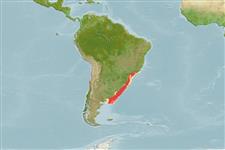Common names from other countries
Classification / Names / Names
Κοινά ονόματα | Συνώνυμα | Catalog of Fishes (gen., sp.) | ITIS | CoL | WoRMS
Environment: milieu / climate zone / depth range / distribution range
Οικολογία
; Γλυκού νερού; εύρος βάθους 4 - 200 m (Ref. 83435). Tropical, preferred 18°C (Ref. 107945); 23°S - 42°S, 74°W - 42°W
Southwest Atlantic and Southeast Pacific: From Rio de Janeiro, Brazil to San Matiás Gulf, Argentina. In the Pacific it is found in Chile. Tropical to subtropical.
Length at first maturity / Μέγεθος / Βάρος / Age
Maturity: Lm ?, range 12 - 13 cm Max length : 27.0 cm DL αρσενικό/απροσδιόριστο; (Ref. 83435)
Minimum depth range from Ref. 122063. Lives in shallow waters at maximum depths of 4 m during low tide. Found on sandy subtrates with boulders and sponges. Individuals spend most of their time buried. Females attach their egg capsules to benthic hard substrata such as mollusk shells and/or pebbles (Ref. 122063). Voracious predator on bivalves (Ref. 114777).
Life cycle and mating behavior
Γεννητική Ωρίμανση | Αναπαραγωγή | Γεννοβολία | Αβγά | Γονιμότητα | Προνύμφες
This species is a non-broadcast spawner. Life cycle does not include trocophore stage. Also Ref. 833.
SAUP Database. 2006. (Ref. 356)
IUCN Red List Status (Ref. 130435)
CITES status (Ref. 108899)
Not Evaluated
Not Evaluated
Human uses
αλιεία: Εμπορικό(ά)
FAO - αλιεία: landings | FishSource | Η θάλασσα γύρω μας
Εργαλεία
Διαδικτυακές πηγές
Estimates based on models
Preferred temperature
(Ref.
115969): 19.5 - 21.2, mean 20 (based on 9 cells).
Ελαστικότητα
Μεσαίο(α), ελάχιστος χρόνος για διπλασιασμό πληθυσμού 1,4 - 4,4 έτη (K=0.21; tm=8.5).
